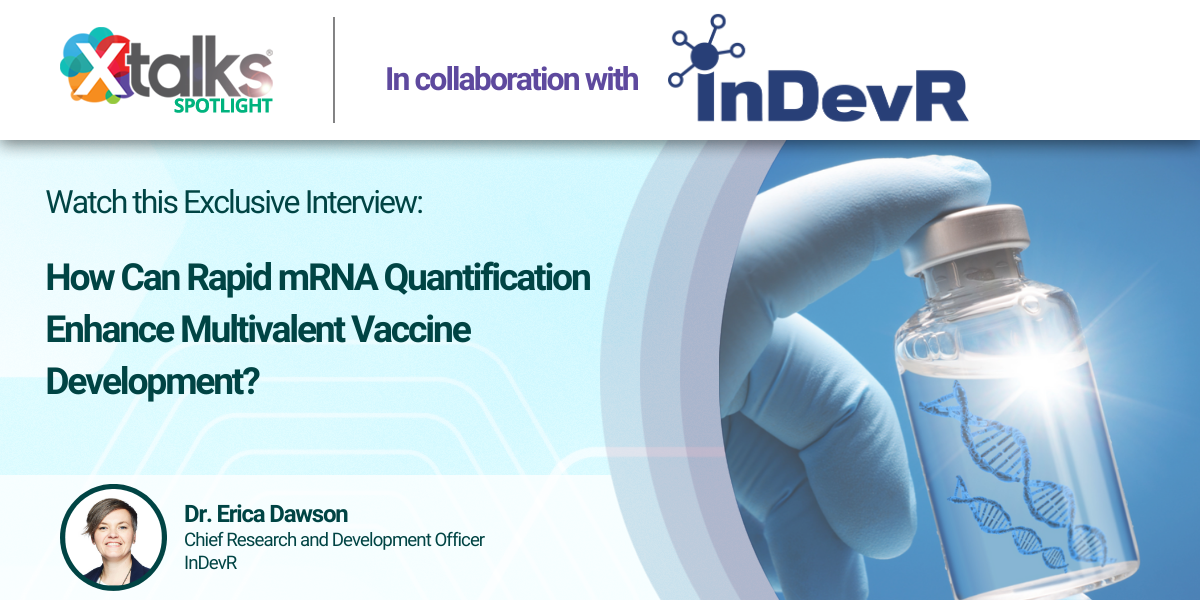The development of mRNA vaccines has revolutionized the field of immunization, offering a rapid, adaptable and effective approach to combating infectious diseases.
However, ensuring their safety, efficacy and stability requires precise characterization throughout the development and manufacturing process.

Manager of Field Application Science
InDevR
Characterizing mRNA vaccines involves evaluating molecular integrity, purity, potency and immunogenicity, as well as ensuring consistent large-scale production. As mRNA technology expands into other disease areas, robust characterization strategies will be essential to unlocking its full potential.
The integrity of mRNA and its 5’ capping efficiency play pivotal roles in ensuring vaccine efficacy.
In this Xtalks Spotlight feature, Randy Lacey, PhD, Manager of Field Application Science at InDevR, sheds light on these critical attributes, the challenges in their assessment and the innovations poised to improve mRNA vaccine characterization.
Critical Quality Attributes: 5’ Capping Efficiency and mRNA Integrity
5’ capping efficiency and mRNA integrity are critical attributes in the overall efficacy of an mRNA vaccine. They are crucial for stability, translation efficiency and eliciting effective immune responses.
5’ capping is the addition of a modified guanosine (typically 7-methylguanosine) to the 5’ end of an mRNA molecule via a 5’-5’ triphosphate linkage. This modification protects the mRNA from degradation, enhances translation efficiency and aids in proper cellular processing.
A proper 5’ cap is essential for mRNA stability as it protects it from degradation and facilitates the translation of the mRNA into the target antigen by enhancing ribosomal recognition. It also reduces innate immune activation and without a properly capped mRNA, the vaccine cannot elicit an effective immune response.
Similarly, mRNA integrity, defined as the amount of full-length, intact mRNA, provides insight into purity.
Dr. Lacey explains that degraded or fragmented mRNA cannot be translated into the appropriate antigen, as compromised integrity can lead to reduced vaccine effectiveness.
mRNA stability is essential for ensuring sufficient protein expression over time, which directly impacts the vaccine’s potency and duration of immune response. Optimizing these factors is key to developing effective and safe mRNA vaccines.
Single-Assay Approach for Evaluating 5’ Capping Efficiency and mRNA Integrity
Traditional methods for evaluating 5’ capping efficiency and mRNA integrity involve the use of multiple, separate techniques.
5’ capping efficiency is generally measured using well-documented mass spectrometry-based approaches that measure the amount of mRNA in solution that has a 5’cap. However, these techniques do not provide information on how much is fully intact — the full-length integrity of mRNA — which is typically assessed via electrophoresis or high-performance liquid chromatography (HPLC).
These measurements, along with an assessment of the poly(A) tail, can collectively provide information about how much mRNA is fully intact and capped, Dr. Lacey says.
InDevR’s approach has been developed to streamline this process.
“Our 5’CapQ assay is an immunoassay-based approach that utilizes an immobilized 5’ cap-specific antibody to capture mRNA that has a 5’ cap,” Dr. Lacey explains.
The assay also employs a fluorescent probe that detects the poly(A) tail, ensuring that only fully intact and capped mRNA is measured.
With a well-characterized reference standard, the assay provides a quantitative assessment of the amount of mRNA that has both a 5’ cap and a poly(A) tail in a single measurement.
ON-DEMAND XTALKS WEBINAR: Measuring Intact mRNA and 5’ Capping Efficiency in One Assay
Register for this free webinar to understand how a multiplexed imaging platform can be used to determine mRNA capping and address mRNA vaccine drug product characterization
Challenges in mRNA Vaccine Characterization
Despite rapid advancements in analytical tools, several challenges remain in mRNA vaccine characterization.
The urgency of the COVID-19 pandemic accelerated vaccine development, requiring quick implementation of analytical tools like PCR, sequencing, mass spectrometry, chromatography and electrophoresis, Dr. Lacey notes.
However, these traditional techniques present bottlenecks, including long wait times, complex sample preparation and data analysis, high costs and inconsistent performance.
“Mass spec-based approaches provide highly precise and accurate results, but they require complex data analysis and specialized expertise, often leading to extended wait times of multiple weeks,” Dr. Lacey points out.
Additionally, immunoblotting and ELISA, commonly used for detecting double-stranded RNA impurities, often lack the sensitivity needed for detecting low-threshold levels of these impurities.
Dr. Lacey explains that another major challenge is the lack of standardization. “There are a wide variety of analytical tools and techniques that are implemented throughout the mRNA vaccine development and production process, many requiring a high degree of specialized knowledge and training.”
Standardizing techniques and adopting more versatile approaches that provide quick and comprehensive results for multiple critical quality attributes can significantly reduce the analytical burden during vaccine development, according to Dr. Lacey.
Risks of Inadequate mRNA Quality Assessment
Ensuring the quality of mRNA in vaccines is paramount for safety and efficacy.
“If mRNA quality isn’t properly assessed, several risks arise,” Dr. Lacey warns.
Fragmented mRNA, for example, may fail to express the required antigenic protein, leading to poor vaccine efficacy with respect to eliciting an immune response.
Another risk involves impurities, including double-stranded RNA, which can cause unwanted immunogenicity. This makes it critical to demonstrate that there is little to no remaining double-stranded RNA in the final product before release.
To mitigate these risks, robust analytical tools for measuring mRNA critical quality attributes are essential. “Beyond implementing effective analytical tools, thorough testing and regulatory compliance are crucial in ensuring mRNA-based vaccines are both safe and efficacious,” Dr. Lacey states.
Innovations to Shape the Future of mRNA Vaccine Characterization
Looking ahead, Dr. Lacey identifies two key areas for improvement: speed and ease of use of analytical tools, and the capacity for multiplexed analysis.
“The faster you can generate analytical data on critical quality attributes of mRNA vaccines, the faster a vaccine can reach the public,” he emphasizes.
If there are delays at each of these manufacturing steps to understand attributes such as 5’ capping efficiency, integrity and purity, this will ultimately lead to delays in the release of drug products.
One way to innovate in terms of speed and ease of use is to implement assays that can generate quicker answers that are high throughput and also easy to use.
For instance, InDevR’s 5’CapQ assay can provide answers on capped and intact mRNA in under two hours — significantly reducing the delays caused by traditional mass spectrometry approaches for 5’ capping data.
“Less time-consuming techniques like the 5’CapQ assay can speed up early-stage development and production processes,” Dr. Lacey says.
Multiplexing is another area where innovation can have a major impact.
Many new mRNA vaccines include multiple unique constructs, making it challenging to confirm mRNA identity and protein expression.
Dr. Lacey says platforms like InDevR’s VaxArray offer high-degree multiplexing, enabling simultaneous measurement of different mRNA constructs and their corresponding levels of protein expression.
As mRNA vaccine research continues to evolve, the need for improved characterization methods remains critical.
Effective mRNA vaccine characterization is necessary for overcoming regulatory hurdles, optimizing manufacturing and ensuring the long-term success of the technology.
Innovations and multiplexing platforms are helping to address key challenges, ultimately accelerating vaccine development with enhanced safety and effectiveness.
The rapid pace of mRNA vaccine development demands continued advancements in analytical techniques, quality control and regulatory frameworks to keep pace with emerging infectious diseases and therapeutic applications.
While challenges remain — such as enhancing stability, scalability and targeted delivery — ongoing innovations in next-generation sequencing (NGS), biophysical analytics and artificial intelligence (AI)-driven modeling are paving the way for even more precise characterization methods to ensure greater vaccine efficacy, safety and accessibility.
This article was created in collaboration with the sponsoring company and the Xtalks editorial team.






Join or login to leave a comment
JOIN LOGIN